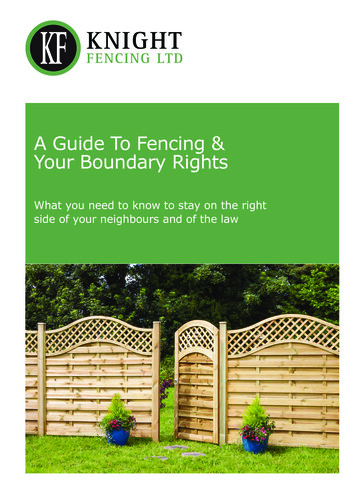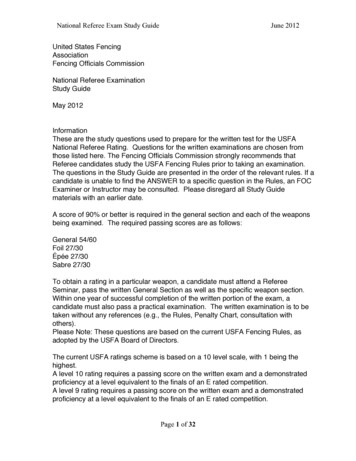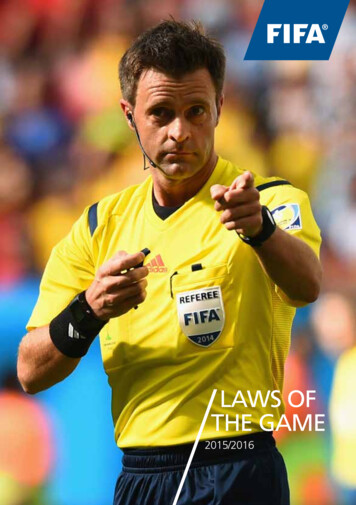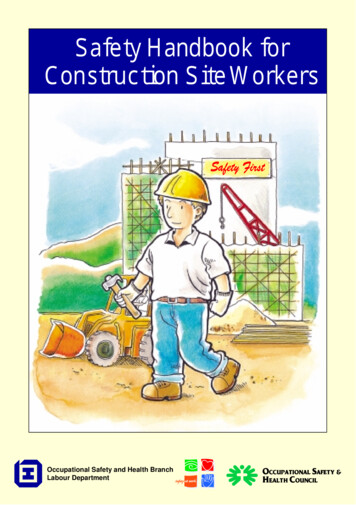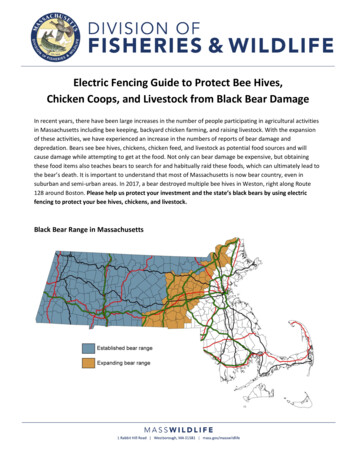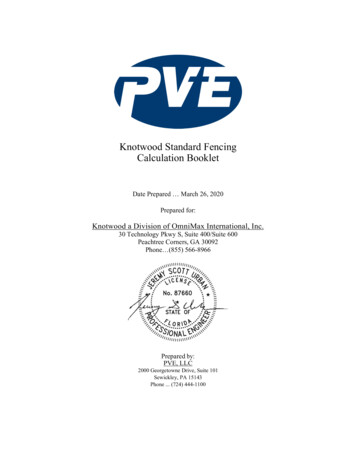
Transcription
USA FencingReferees’ CommissionNational Referee ExaminationStudy GuideInformationThis packet contains sample test questions and outlines that will enable you to not only pass theonline test, but also give you practical guidance on refereeing in reality. Included are many studyquestions to prepare for the examination to earn a USA Fencing Referee Rating. The Referees’Commission strongly recommends that referee candidates study the current USA Fencing Rulebookprior to taking the examination and complete this study guide. We recommend printing this documentdouble-sided, (if possible two pages per sheet) as it is 58 pages. The last two pages should beseparated for ease of completing the sample test and taking notes on topics you need to study more.Passing RequirementA score of 90% or better is required in the general section and each of the weapons sectionsexamined. The required passing scores on the exam are as follows: General 54/60 questions Foil 27/30 questions Epee 27/30 questions Sabre 27/30 questionsNOTE: Those desiring to take the National Referee Exam should be referred to the online test foundon the website of USA Fencing in the Referees est Specifications Log in to your profile, pay for the test and click on appropriate links to start it. Referee candidates have 48 hours to pass the general plus weapon sections. IMPORTANT: The test is to be completed without any resources, including this study guide!Check out the USA Fencing website (see screenshot below) to find detailed information:For more information, contact the Referee Development Committee of the Referees’ CommissionEmail: referees@usafencing.org.1
Realize that you wantto become a referee.StepsTo Becomea RefereeRead Rulebook.Begin to practice refereeing at clubSafeSport Process forReferees 18 years or OverLog on to USAFencing ProfilePurchase CheckEdInitiate background screenSign up for areferee clinicrun by aCertifiedRefereeInstructor(CRI)Print out study guideReview study guideComplete free U.S. Centerfor SafeSport TrainingReceive “green light”You are now officiallyeligible to referee!Attend Clinic. Note: Referee candidates areREQUIRED to attend a clinic to become a “P.”Take online test.Candidates have 48 hours to pass thegeneral AND weapon specific tests.Complete clinic and test to become a “P.”Ratings FundamentalsContinue to practice refereeing.Complete SafeSport if 18yrs or over.Connect with an Observer in your region.Set up a tournament to be observed inyour preferred weapon(s).Earn a rating at a tournament!Congratulations, you are a referee!2 A level P: passing score on the written exam.A level 10: referee the finals of an E rated competition.A level 9: referee the finals of a D rated competition.A level 8: referee the finals of a C rated competition.A level 7: referee the finals of a B rated competition.A level 6: referee the finals of an A rated competition.A level 5: referee the round of pools in an Open NACOR final of an A1-A4 level Regional event.A level 5 rating must be earned before subsequent ratings A level 4: referee the DE round of 64 of an Open NAC. A level 3: referee the DE round of 16 of an Open NAC. A level 2: referee the DE round of 8 of an Open NAC. A level 1: referee any bout at an Open NAC.
Rulebook BasicsThe rulebook for USA Fencing is divided into four main sections. The FIE Rulebook publishes themas separate documents. Many years ago USA Fencing thought it better to have them all in one place. Technical Rules: dealing with technical descriptions of fencing and its equipment. Example: t.170 Organizational Rules: dealing with organization and control of fencing competition. Example: o.14 Material Rules: dealing with weapons, scoring equipment and their specifications. Example: m.25 Publicity Code: dealing with advertisements and sponsorship. (excellent cure for insomnia)Study Guide Basics Have a copy of the most current rulebook, either in print or on a computer. Be prepared to page through the rulebook as you answer the sample questions. You can usethese later to study for your test. Remember, when you take the test, it is to be taken WITHOUT resources. Many fencers are very visual. Try drawing out a strip. And draw on it Fencer X and Fencer Y.Fencer X Fencer YAt the end of each section: make notes on the information where you need more studying.Answer the sample questions without accessing the answer pages.Separate the last two pages of this study guide. The last page is an answer sheet. Complete asection and then go over the answers. Be sure to make notes on topics you need to review.Review the answers and if you have any questions consult a Certified Referee Instructor (CRI)Testing Tips After completing the entire study guide, set a date for you to take the test. Dedicate time enough to be able to take and re-take the test several times. Remember you have 48 hours to pass all four sections. It is recommended that you take ALL thesections. You are required to pass the general section and your preferred weapon. However, tomake yourself more marketable to be hired, it is highly recommended that you have competencyin at least two weapons. Make sure you are in a quiet space so you can concentrate. Draw out your strip with Fencer X and Fencer Y. Read questions carefully and try to break the question down to the foundation of what it is asking.Look for temporal words like “during,” “after,” “then,” “immediately,” – it will help you get down tothe essence of the question.Sample QuestionFencer X makes an attack, which is parried. Fencer Y had made a sideways sweep with their blade toparry Fencer X’s attack and after the parry, Fencer Y’s blade became tangled in the cloth curtain onthe bottom of the score table. Fencer X then starts a remise which lands valid. What should thereferee do?A. Allow Fencer X’s touch as Fencer Y had chosen to fence on the side of the strip closest to thescore tableB. Annul Fencer X’s touch. Fencer X receives a YELLOW CARD for hitting Fencer Y when theywere unable to defend themselves.C. Annul Fencer X’s touch.3
Sample Question (continued)Tip for figuring the answer: First, picture the action. Next, break it down to its essence. A fencer’sblade was caught up and then an action started, therefore, no touch.Key: Why did I call the halt? Did the action happen after the halt?Sample Question Answer: (C). Fencing cannot continue when a fencer cannot defendthemselves. When Fencer Y’s blade becomes tangled in the cloth curtain on the scoring table,the referee should call “Halt!” All hits scored after a call of “Halt!” must be annulled, so FencerX’s touch should be annulled. Relevant Rule(s): t.23.3, t.23.5.General Questions Study GuideUniform, Plastron (Under arm protector), Chest Protection, Mask (t.64, t.71, t 75, m.25-m.27)Uniform Basics: No holes and no tears in any of the uniform Jacket has a 10cm overlap over pants (in on guard) Plastron required (in foil over chest protector) Chest protector required for ALL female fencers. In foil, any chest protector must be covered with an FIE/USA SEMI approved soft materialAND the plastron must be OVER the chest protection. Name for events that require it must be 8 to 10cm (high) 1 to 1.5cm(wide), navy blue, blockletters on the back between shoulders. USA competitions: can also be on fencer’s REAR leg. Fencing pants must be worn- there are no substitutes like: sweat pants, shorts, jeans, etc. Gloves must be free of holes, have an inspection mark and cover the lower half of the forearm. Mask must have a horizontal strap (elastic strap) which fastens low on the back of the head. Mask must be inspected for safety. Absolutely no visor masks allowed. There are three different masks (one for epee, foil and sabre). For example, an epee fencerCANNOT use a foil mask (even if taped) to fence in a competition. Inspection of mask, plastron, lamé, cords, etc. MUST BE verified before every bout (pool,direct elimination, team, etc.)Uniform Sample QuestionsG1. The requirements for the format of the name on the uniform are that:A.The letters must be legible from sixty meters.B.The letters must be in dark blue, in capitals, between 8 cm and 10 cm high, and between 1 cmand 1.5 cm wide, according to the length of the name.C.The letters may be any color, in capitals, and legible from 30 metersAnswer: ( ). Notes:Relevant Rule(s):G2. The protective plastron must be checked at the beginning of each:A.Tournament.B.Bout.C.Pool, team match and direct elimination bout.Answer: ( ). Notes:Relevant Rule(s):4
G3. What action should a Referee take if a fencer reports to the strip with a jacket that has a tornsleeve?A.Fencer receives a YELLOW CARD; confiscate jacket and allow a reasonable amount of timefor the replacement.B.Fencer receives a RED CARD; confiscate jacket and allow a reasonable amount of time for thereplacement.C.Allow a reasonable amount of time for the replacement or repair; no penaltyAnswer: ( ). Notes:Relevant Rule(s):G4. A fencer in a Y-12 women’s sabre competition presents to the strip without chest protection andwithout a plastron (underarm protector). The rules instruct the Referee to:A.Allow her to fence as sabre is not a point weapon.B.Allow her to fence as this is a youth competition.C.Fencer receives a RED CARD; allow a reasonable amount of time to obtain conformingequipment.Answer: ( ). Notes:Relevant Rule(s):G5. A fencer at a national event reports to the strip without their last name on the back of theiruniform between the shoulders What is the correct outcome?A.The fencer receives a YELLOW CARD unless the name appears on the fencer’s rear leg;allow them to fence.B.The fencer receives a RED CARD unless the name appears on the fencer’s rear leg; allowthem to fence.C.No penalty if the fencer is wearing an armband bearing their national colors.Answer: ( ). Notes:Relevant Rule(s):G6. Fencer comes to the strip and the mask’s tongue/ spring does not touch the back of the fencer’shead and the elastic strap does not lay next to the lower back of the head. What does the referee do?A.Since the mask has the proper inspection mark, it must be safe. The referee should let thefencer fence.B.Require the fencer to fix the tongue of the mask, then proceed with the bout.C.Require the fencer to fix the tongue and the elastic strap, then proceed with the bout.Answer: ( ). Notes:Relevant Rule(s):G7. Before the start of the bout and with no other penalties given, the Referee notices that there is nosafety strap on the back of the mask of Fencer X.A.Start the bout since the mask had passed the initial inspection and has been stamped.B.Fencer X receives a YELLOW CARD. Fencer X must affix a horizontal safety strap on themask or the referee must confiscate the mask.C.Fencer X receives a YELLOW CARD, and is allowed to fence with the mask as is.Answer: ( ). Notes:Relevant Rule(s):Additional Notes:5
Strip Basics (t.16 through t.19) The proper distance for fencers to come on guard (when not at the on guard lines) is such thatwhen the fences are in point in line position while on guard, their points do not overlap.However, referees do not start bouts (in foil & sabre) with fencers in point in line position. See the below diagram- The fencing strip is 14 meters long -1.5 to 2 meters wide. (Note: thisdoes not include run-off) A fencer with one foot off of the SIDE of the strip is a “halt.”If a fencer has one foot off the side of the strip, that fencer loses ONE meter from the start ofthe attack. If the fencer is less than one meter from the back end of the strip (meaning they aredeep into their two meter warning zone), it can place the fencer off of the back of the strip andaward a touch to the opponent.If a fencer has one foot off, that fencer can score provided the action is started before the “halt”Both feet off the side of the strip, has the same applications of losing one meter.Both feet off of the rear limits is a touch for the opponent. If the referees halt is for a fencerleaving the rear limits, that fencer’s touch is annulled, but s/he can be scored upon, providedthe action began before the “halt.”Strip Rules Sample QuestionsG8. Fencer X executes an attack. After scoring a valid touch, Fencer X then leaves the side of thestrip with both feet. What should the Referee do?A.Annul the touch; Fencer X retreats one meter.B.Annul the touch; Fencer Y remains in place and Fencer X assumes normal distance.C.Award a touch for Fencer X.Answer: ( ). Notes:Relevant Rule(s):G9. Fencer X makes an attack. Fencer X is off the side of the strip in front of Fencer Y with both feetbefore Fencer Y parries and starts his riposte. Fencer Y’s riposte lands valid. What should theReferee do?A.Do not award a touch; place the fencers on guard where they were, but in the lateral center ofthe strip.B.Do not award a touch; have Fencer X return to the position held on strip at the start of theattack and Fencer X then retreats a meter.C.Award a touch for Fencer Y.Answer: ( ). Notes:Relevant Rule(s):6
G10. During an advance-lunge attack, Fencer Y steps off the side of the strip with one foot during theadvance, but recovers the strip and then scores a valid touch on Fencer X. What should the Refereedo?A.Do not award a touch; place the fencers on guard where they are.B.Award a touch for Fencer X.C.Do not award a touch; Fencer Y returns to the place in the strip where they started theadvance-lunge attack and then retreats an additional meter.Answer: ( ). Notes:Relevant Rule(s):G11. Fencer Y has retreated behind the end line with both feet while parrying Fencer X’s attack.Fencer Y makes an immediate valid riposte. What should the Referee do?A.Award a touch for Fencer X.B.Award a touch for Fencer Y.C.Do not award any touch.Answer: ( ). Notes:Relevant Rule(s):G12. During an action, Fencer Y goes off the side of the strip with one foot between Fencer X and theend line. Y was standing with his front foot one half meter in front of his own end line at the start ofthe action. What should the Referee do?A.Advance Fencer X one meterB.Award a touch for Fencer XC.Place Fencer Y back on the strip with Fencer Y’s rear foot at the end lineAnswer: ( ). Notes:Relevant Rule(s):G13. Fencer X is attacking and steps off the side of the strip with one foot during the attack, but doesnot hit his opponent. The Rules direct the Referee to:A.Call “Halt!” and have Fencer X retreat one meter from where Fencer X's offensive actionstarted.B.Call “Halt!” and place Fencer X back on guard where Fencer X's foot went off the strip, butreturn the fencers to the lateral center.C.Allow the action to continue.Answer: ( ). Notes:Relevant Rule(s):Additional Notes for Uniform and Strip Rules:7
Penalty Chart (t.170) BasicsThe full penalty chart of t.170 and knowledge of these rules are vital to refereeing. Remember, thischart is an abridgement of the rules. Look up the full rules for more details. Having a reference handywhen you referee is helpful.Group 1 Penalties (Cards)Penalty lasts for the boutYellow plus 2nd offence equals Red Card(touch for the opponent) (in same bout)Group 2 Penalties (Cards)Penalties that are automatic Red Card(touch for opponent)Group 3 Penalties (Cards)Can be Red/Yellow or straight to Black(Red for fencer - Yellow for spectator)Group 4 Penalties (Cards)Behavioral penalties that go immediately to Black CardKey: Referees issue penalties from lesser to greater. Meaning if a fencer has performed a YellowCard penalty AND a Red Card penalty. The referee issues the yellow one first and then the red.Because if a referee issues the red first, that penalizes the athlete more than the rules allow. Any non-conforming equipment is confiscated only for the bout. Equipment that has a fault (not working) that occurs during a bout is not issued a card. Fencers must be present at the start of a pool, DE bout, or team match. Fencers are allowedthree calls before being eliminated: First call (not present) is a Yellow Card. Second call (viapublic address system) at one minute is a Red Card. If still not present at Third call, fencer iseliminated from the competition. Make special note of the key at the bottom of the chart. An asterisk means that if a fencerscores while creating a penalty, that action (and it’s scoring touch) gets annulled. Always write down the issuing of penalties onto the scoresheet.Penalty Chart Sample QuestionsG14. During a halt, a fault is found in Fencer Y’s equipment; the equipment appears fraudulent. Whatshould the Referee do?A.Confiscate Fencer Y’s equipment; before deciding on any penalty, consult the technical expert.B.Confiscate Fencer Y’s equipment; Fencer Y receives a YELLOW CARD.C.Confiscate Fencer Y’s equipment; Fencer Y receives a RED CARD.Answer: ( ). Notes:Relevant Rule(s):G15. Fencer X has a YELLOW CARD. During a halt, Fencer X’s weapon is found not to conform tothe Rules with a fault that could have been caused by the fencing. What should the Referee do?A.Confiscate Fencer X’s weapon; Fencer X receives a YELLOW CARD.B.Confiscate Fencer X’s weapon; no additional penalty is required.C.Confiscate Fencer X’s weapon; Fencer X receives a RED CARD.Answer: ( ). Notes:Relevant Rule(s):8
G16. No penalties have been given. While retreating, Fencer Y parries Fencer X’s attack andripostes, touching X on the valid surface, which is registered on the machine. Y retreats then falls; X’sremise arrives on the valid surface, which is registered on the machine. What should the Referee do?A.Award a touch for X; Y receives a YELLOW CARD.B.Annul all touches; Fencer Y receives a YELLOW CARD.C.Award a touch for Fencer Y.Answer: ( ). Notes:Relevant Rule(s):G17. In a pool bout, Fencer X has received a YELLOW CARD for non-conforming equipment and islosing 3-2. Fencer Y attacks and scores a valid touch while X trips and falls. What is the outcome?A.Fencer X is now losing 4-1.B.Fencer X has lost the bout 5-2.C.Fencer X is now losing 4-2.Answer: ( ). Notes:Relevant Rule(s):G18. Having already received a YELLOW CARD for raising the mask before the Referee called Halt!Fencer Y parries while turning the back to the opponent and then makes a riposte that arrives on theopponent’s valid surface. What should the Referee do?A.Annul Fencer Y’s touch; Fencer Y receives a YELLOW CARD.B.Annul Fencer Y’s touch; Fencer Y receives a RED CARD.C.Award Fencer Y’s touch; Fencer Y receives a RED CARD.Answer: ( ). Notes:Relevant Rule(s):G19. In a pool bout, Fencer X has received a YELLOW CARD for non-conforming equipment and iswinning 4-2. X attacks, sees the machine register a valid touch and, in excitement, removes the maskbefore the Referee calls Halt! What is the outcome?A.Fencer X has won 5-3.B.Fencer X has won 5-2.C.Fencer X is now winning 4-3.Answer: ( ). Notes:Relevant Rule(s):G20. During the bout, Fencer X has received a RED CARD for disturbing order on the strip. X repeatsthe offense and receives a BLACK CARD. Fencer X protests the issuance of the BLACK CARDbecause the RED CARD was not noted on the scoresheet. What is the correct outcome?A.Award a penalty touch for Fencer X’s opponent because of Fencer X’s unjustified appeal; theexclusion of Fencer X stands.B.Fencer X’s protest is valid; Fencer X receives a RED CARD (noted on the score sheet) fordisturbing order.C.No additional touch for Fencer X’s opponent; the exclusion of Fencer X stands.Answer: ( ). Notes:Relevant Rule(s):Additional Notes:9
G21. Fencer Y is losing. Fencer Y allows Fencer X to score a touch without attempting to defend.What is the correct outcome?A.Fencer Y receives YELLOW CARD.B.Fencer Y receives RED CARD.C.Fencer Y receives a BLACK CARD.Answer: ( ). Notes:Relevant Rule(s):G22. Having already received a Group 1 YELLOW CARD in the current bout, Fencer X commits adifferent offense from the same group. What is the correct outcome?A.A previous touch scored by Fencer X is removed.B.Fencer X receives a RED CARD. Point awarded to Fencer Y.C.Fencer X receives another YELLOW CARD.Answer: ( ). Notes:Relevant Rule(s):G23. In a previous bout in the same pool, Fencer X committed an offense requiring an immediateGroup 2 RED CARD. With no other penalties given in the current bout, Fencer X commits the sameoffense. What should the Referee do?A.Exclude Fencer X from the competition.B.Fencer X receives a RED CARD.C.Consult the Bout Committee.Answer: ( ). Notes:Relevant Rule(s):G24.No penalties have been given. Fencer X attacks. Fencer Y makes a parry, and scores a riposteto the valid target of Fencer X. During the parry, Fencer Y strikes Fencer X’s mask with the bellguard. What should the Referee do?A.Annul the touch; Fencer Y receives a RED CARD.B.Award a touch for Fencer Y.C.Annul the touch; Fencer Y receives a YELLOW CARD.Answer: ( ). Notes:Relevant Rule(s):G25. Fencer Y makes an attack and Fencer X makes a counter attack by ducking. Fencer Y’s attackmisses and Fencer X touches on valid target as Fencer X falls over backwards. The referee should?A.Award a touch for Fencer X.B.Annul the touch made by fencer X. Resume the bout from that point.C.Annul the touch made by Fencer X. Fencer X receives a YELLOW CARDAnswer: ( ). Notes:Relevant Rule(s):G26. In a pool bout, Fencer Y unjustifiably complains about an analysis of a phrase after havingreceived a YELLOW CARD penalty for covering target earlier in the same bout. What is the correctoutcome?A.Fencer Y receives a RED CARD.B.Fencer Y receives a YELLOW CARD.C.Fencer Y receives a BLACK CARD.Answer: ( ). Notes:Relevant Rule(s):10
G27. Having already received a YELLOW CARD for a failed weapon, Fencer X presents anotherweapon, which passes. Fencer X’s coach asks to take the first failed weapon for repair while FencerX is in the current bout. What should the Referee do?A.Decline the request to take the weapon for repair as it is confiscated until the bout is complete.B.Allow the coach to take the weapon for repair.C.The request to take the weapon is declined. Fencer X’s coach receives BLACK CARD.Answer: ( ). Notes:Relevant Rule(s):G28. When checking the equipment at the start of a direct elimination bout, the Referee immediatelyfinds that Fencer X’s mask does not have the required inspection mark. Right after that, the refereefinds that that Fencer X is not wearing an underarm protector. What should the score be at the start ofthe bout?A.The bout starts with Fencer X losing by a score of 0-2.B.The bout starts with Fencer X losing by a score of 0-1.C.If Fencer X can quickly correct the problems, the score is 0-0.Answer: ( ). Notes:Relevant Rule(s):G29. Prior to the start of a competition a coach is seen giving a warm up lesson to a student who iswearing only shorts, and a t-shirt. The referee must:A.Allow the lesson to continue.B.Issue a YELLOW CARD to both fencer and coach; the lesson cannot continue until the studentis wearing a protective mask.C.Issue a BLACK CARD to both fencer and coach.Answer: ( ). Notes:Relevant Rule(s):Additional Notes for Penalty Chart Questions:Fundamental Actions Notes (t.2 through t.15)A referee knows the basic definitions of fencing terms. Referees know the basic definition of bout,match, competition, tournament, championships. Make sure you can define the following: attack,riposte, counter-riposte, parry, relative to attacks and ripostes- direct/ indirect, disengage, coupé,doublé, fleche, counter-attack, stop hit, remise, redoublement, reprise, circular defense, point in line,corps à corps. Take notes on terms you are unfamiliar with. Corps à corps: the fencers come into body contact (corps à corps) without jostling orattempting to avoid the touch. (Exists in ALL three weapons) Constitutes a halt. 11
Fundamental Actions Sample QuestionsG30. As Fencer X makes a straight attack, the Referee notices that Fencer Y is in danger of trippingover the reel. The Referee calls “Halt!”. At the moment of the command “Halt!” Fencer Y makes aparry and then an immediate riposte that lands valid on Fencer X. What should the Referee do?A.Do not award the touch.B.Award a touch for Fencer Y.C.Do not award the touch; Fencer Y receives RED CARD for continuing to fence after thecommand “Halt!”Answer: ( ). Notes:Relevant Rule(s):G31. Fencer X stops for any reason other than the Referee’s command “Halt!” during fencing and ishit valid by Fencer Y. What should the Referee do?A.Annul touch by Fencer Y.B.Award a touch for Fencer Y.C.Annul touch by Fencer Y only if there were loud and confusing noises.Answer: ( ). Notes:Relevant Rule(s):G32. Fencer X drops the weapon after Fencer Y executes a parry. Fencer Y’s immediate ripostescores a valid touch. What should the Referee do?A.Annul the touch.B.Award a touch for Fencer X.C.Award a touch for Fencer Y.Answer: ( ). Notes:Relevant Rule(s):G33. Fencing at close quarters is allowed so long as the competitors can:A.Possibly score a touch, within three actions.B.Maintain a minimum separation of 10 centimeters apart.C.Wield their weapons correctly and the Referee can, in foil and sabre, follow the phrase.Answer: ( ). Notes:Relevant Rule(s):G34. After causing incidental corps à corps with Fencer Y, Fencer X then leaves the side of the stripwith both feet. No penalties have been given What should happen?A.For all three weapons, call Halt!; no penalty.B.Call Halt! only for sabre and foil; the fencer(s) who caused the corps corps receive(s) aYELLOW CARD; for epee allow fencing to continue as long as the action is not dangerous.C.For sabre and foil, call Halt!; the fencer(s) who caused the corps corps receive(s) a YELLOWCARD; ie only call Halt!Answer: ( ). Notes:Relevant Rule(s):Additional Fundamental Action Notes:12
Duration of the bout, Injury Break rules (t.37 through t.45), and Etiquette (t.121) Basics Pool bouts: (open, veteran, and youth) 5 touches - maximum of 3 minutes of fencing time. No time kept in sabre pool bouts GENERALLY. Team relay bouts: each bout to intervals of 5, 10, 15 etc. touches - 3 minutes per relay,Maximum of 45 touches for entire match. No time kept in sabre team bouts. The referee is responsible for the ensuring that the time keeping is done correctly. Rest between consecutive bouts 3 minutes - pool bout; 10 minutes - DE bout. All Open-Junior-Youth14-Youth12 Direct Elimination: 15 touches. Three - 3 minute periodswith 1 min. rest. Sabre DE gets rest break at 8 touches. Note: Y10-Y8 REQUIRED to use shorter blades for competition. (Blades must be “0” or “2”) Y10- Y8 DE bout (ALL weapons)- 10 touches-TWO-3 minute periods break at 5 touches ORbreak at 3 minutes whichever comes first. Non-Combativity rules apply in regular, youth and vet DEs. (Also in team relay matches) Veteran DE bouts are 10 touches. Veteran Foil/Epee DE: 10 touches in TWO-3 minuteperiods. Veteran Sabre DE: break at 5 touches During the breaks ONE person is allowed to speak to the fencer. If at the end of regulation time the scores are equal, the fencers fence for a deciding touch,with a maximum time limit of one minute.o Before the fencing recommences, the referee will determine priority to decide who willbe the winner if scores are still equal at the end of the extra minute.o In epee, during this minute, when double touches occur, points will not be awarded, thescore will not change, and the fencers will retain their respective positions on the strip.Injury Break A 5 minute injury break (verified by medical) for treatment is allowed per body part. Muscle cramps (medical staff specifying cramp location) are allowed the 5 minute injury break. Injury breaks are ONLY for medical issues that occur during the course of a bout (on that day).Etiquette Begin and end each the bout with fencers behind their on guard lines (4 meters apart). Mandatory salute: (before and after a bout) salute to the opponent, referee, and audience. Fencers must be still before the command “fence” Mask must be on during referee’s decision. End of bout: (via score or time elapsing) fencers must return to their guard line, do themandatory salute and then shake (non-weapon) hands with their opponent.Duration, Injury and Etiquette Sample QuestionsG35. Is a touch recorded on the scoring apparatus after time has expired ever awarded?A.If it is an immediate riposteB.If the action began before the “Halt!”C.No.Answer: ( ). Notes:Relevant Rule(s):G36. During a bout the referee notices that the clock has stopped working. If the clock fails, theReferee should:A.Retain the touch score and restart the clock.B.Retain the touch score and restart the clock with one minute remaining.C.Retain the touch score, estimate the time expired, and continue the bout from that point.Answer: ( ). Notes:Relevant Rule(s):13
G37. Fencer X has already had a verified sprained ankle occur in the current bout and has taken afive minute injury treatment break. During a subsequent action, Fencer X sprains a finger. Whatshould the Referee do?A.If requested and verified by available medical authorities, allow Fencer X another five minutebreak for treatment of the new injury.B.Award a touch for Fencer X’s opponent.C.Require Fencer X to continue as only one injury time per bout is allowed.Answer: ( ). Notes:Relevant Rule(s):G38. At the end of a pool, the Referee should:A.Immediately total all indicators, announce the results, have all fencers sign the score sheet,and then return the score sheet to the Bout Committee.B.Immediately have the fencers check and sign the score sheet, and return the score sheet tothe Bout Committee.C.Return the score sheet to the Bout Committee.Answer: ( ). Notes:Relevant Rule(s):G39. The score in a bout is 4-2 and time expires before the maximum number of touches has beenscored. What should the referee do?A.The touches for each fencer are advanced by one simultaneously, until one fencers scorereaches the maximum number of touches. V5-3B.The score is recorded as it was at the expiration
2 To Become You are now officially Ratings Fundamentals A level 5 rating must be earned before subsequent ratings A level P: passing score on the written exam. A level 10: referee the finals of an E rated competition. A level 9: referee the finals of a D rated competition. A level 8: referee the finals of a C rated competition. A level 7: referee the finals of a B rated .
